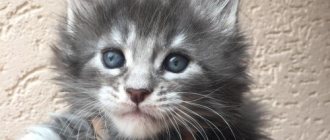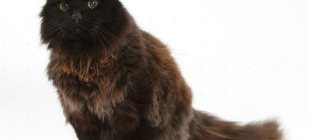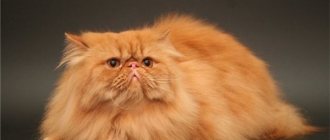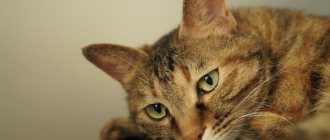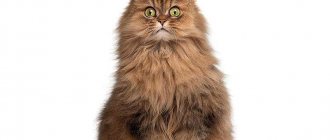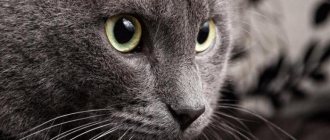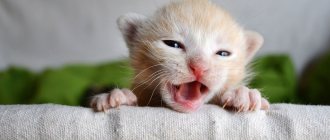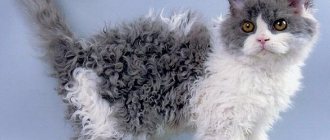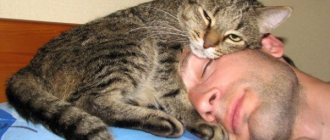Causes of white color: a little genetics
Let's look at the reasons for the appearance of this color.
The reason for the snow-white coat color lies in the following genes:
- The albinism gene disrupts the production of the coloring substance melanin, so these creatures are colorless rather than white. Their characteristic feature is the red color of their eyes. Life expectancy is very low;
- The white color gene slows down the movement of melanoblasts, which are responsible for pigmentation. The dyes reach the already developed hair follicles when the fur has already turned white. As for eye color, when the pigment content is low, they become blue, and when the pigment content is high, they become yellow;
- The piebald gene contributes to the appearance of white spots, the boundaries between which are completely invisible. And these animals are perceived as pure white. But such cats are very rare.
Representatives with white color often have hearing problems. The reason for this is the white color gene. Sound sensations in the ear arise due to the endolymph. Cells with insufficient pigment secrete little endolymph and mutations and hearing loss occur.
Deafness can be complete or partial. Cats with different colored eyes will have a deaf ear on the side with the blue eye.
But deafness in cats is compensated for by other sensations. The animals do not feel any particular discomfort and feel quite healthy.
Did you know? White cats are considered good healers (they are especially good at lowering blood pressure), and cat purring is similar to treatment with acoustic vibrations.
Keeping Russian White, Russian Black and Russian Tabby cats
Cats of the Russian White , Russian Black and Russian Tabby are animals with very good health. With proper care, they give their love to owners aged 13 years or more.
The fur of these creatures is soft, silky and thick. No special maintenance measures are required. Brushing once a week is enough to give the animal a well-groomed appearance. Also, trim your pet’s nails regularly and then your pet will be happy and grateful.
White breeds
Among many breeds there are representatives with snow-white coat color.
Turkish Angora
Animals of this breed are distinguished by their bodies with well-developed muscles. The pointed ears are placed high on the wedge-shaped head. Lush fur and fluffy tail. Eyes are blue or multi-colored. They are curious and friendly. They don't like to be alone. They love water treatments.
Scottish lop-eared
Blue-eyed Scots are highly valued for their uniqueness. They have smooth, shiny coat without yellowness. The floppy ears give them an innocent look.
British Shorthair
These cats have a squat and muscular body. Their soft skin with short hair and puffy cheeks give them a resemblance to teddy bears.
From the history of cats: Russian White, Russian Black and Russian Tabby
Australia is considered the birthplace of cats. Facing many difficulties and misunderstanding from other specialists, Dick and Mavis Jones finally achieved that the Russian White , Russian Black and Russian Tabby were officially recognized by the Royal Agricultural Society (RAS) club. It took 4 whole years. Only in 1975 cats of this breed received the right to compete for the title of Champion. , Russian White , Russian Black and Russian Tabby cat breeds are recognized in New Zealand, South Africa, and are gradually moving to Europe, England and the USA. In 2010 The American Association ACFA recognized the Russian White and Russian Black breeds and they were awarded champion status.
Kurilian Bobtail
A distinctive breed feature of the Kuril Bobtail is a short tail in the form of a hook or pom-pom several centimeters long. Short-tailed cats (or those with shortened or broken tails) are extremely common, especially in East and Southeast Asia. So, on the Kuril Islands they are found all the time.
The first, still Soviet felinologists, tried to find the “relatives” of cats from the Kuril Islands. It turned out that they are very similar to representatives of a long-existing breed - the Japanese Bobtail. However, there are many differences in the appearance of the fluffy island aborigines and Japanese bobtails. And then domestic breeders decided to breed a new breed. In the mid-90s of the last century, it was recognized as one of the felinological systems, and soon by many others.
Khao-mani
A snow cat that came to us from Thailand. Its name, translated from Thai, sounds like “white gem”. And indeed, most often, Kao-mani kittens, born with a dark spot on their heads, change it to perfectly white, iridescent fur as they grow. The cat's eyes are emerald, blue or amber, and are rarely heterochromic. As a distinctive feature of Kao-mani, one should also highlight the often occurring hearing loss of the animal in one or both ears at once.
Devon Rex and Cornish Rex
A breed that appeared by chance. Its peculiar curly fur, very similar to sheep’s, is the result of a rare gene mutation. These cats are considered an ideal breed for allergy sufferers due to their lack of guard hair. The large expressive eyes of these cats can melt even the hardest heart. Particularly rare and expensive are representatives of the breed with blue eyes. These cats are unusually good-natured, affectionate and intelligent. Breeders jokingly call these cats “catdogs.” This is due to the fact that the animal is quite easy to teach certain commands and is calm about walking on a leash.
Ural rex
The birth of a cat with wavy fur is not uncommon; they are found in many parts of the world. In Russia, such a corner is located in the vicinity of Yekaterinburg. Although the curly (rexoid) gene “walks” near Yekaterinburg and appears from time to time in outbred cats, representatives of the new breed trace their pedigree back to one cat born in 1988.
Several nurseries in Russia and Germany work on the breed. It is recognized by several felinological systems, and in two variations: short-haired and semi-long-haired. However, so far the Ural Rexes are not very popular among ordinary cat lovers.
Peterbald (Petersburg Sphynx)
Graceful Oriental cats have always had many fans. A new breed, the Don Sphynx, formed in the early 90s, also appealed to many cat lovers. And it so happened that connoisseurs of everything refined decided to combine the grace of Orientals and the most delicate velor skin of the Don Sphynx (which has a dense physique and a noticeable tummy). The idea came to the minds of St. Petersburg breeders, which is how the breed got its name. But breeders from other Russian cities also liked the idea. The selection work was successful - already in the mid-90s, the Peterbald was registered by one of the felinological systems.
General information
Fact: White cats do not always suffer from hearing loss; blue-eyed pets are more likely to suffer from it. Neither complete nor partial lack of hearing worsens the animal’s quality of life: a developed sense of smell and sensitivity to vibrations compensate for the impairment.
Names of popular breeds of white cats:
- Persian
- Angora cat (Turkish Angora)
- British Shorthair
- Balinese cat (Balinese)
- Maine Coon
- Khao Mani (Diamond Eye (from English - “diamond eye”))
- Russian white cat
- Cornish Rex
- Scottish lop-eared
- Exotic
Neva masquerade cat
The history of the breed with a somewhat theatrical name began simultaneously with the history of the Siberian. In fact, Nevaks (as breeders call representatives of the breed) are the same Siberians, but with a colorpoint color (popularly called Siamese). The fact is that representatives of any breed must meet certain standards. Standards that describe the appearance of animals in great detail are approved by special commissions of felinological systems.
There are over a hundred cat colors, and there is no breed where the standards allow any of them. This happened with Siberians - several colors, including colorpoint, were included in the list of disqualifying characteristics.
But not everyone agreed with this. Luxurious cats with dark paws, tail, muzzle and light body had and still have many fans. Soon a new breed was registered - the Neva Masquerade. True, not all felinological systems recognize it, and some simply introduced the colorpoint color to the list of permitted colors for the Siberian cat.
Child of the Siberian expanses
Historical justice triumphed when the best furry representatives from Siberia and the Far East were involved in the breeding work. These animals were quite varied in terms of coat color and texture, as well as size. For example, people from Kemerovo, Krasnoyarsk and Novosibirsk were endowed with very fine hair, and Far Eastern cats were distinguished by massive bones and coarse long fur. In a word, breeding work aimed at breeding an original breed of true Russian origin was difficult and painstaking.
Bengal cat breed
If you can still find a common language with an Angora and a Siberian cat, then Bengal cats are not at all used to negotiating. The breed combines wild roots and domesticated kindness. Which of these two essences will manifest itself in a particular pet depends only on the owner.
Breed standard
The Bengal breed was developed in 1963 in America. Its ancestors were a domestic cat and a wild leopard. The exterior that the breed inherited is impressive:
Table 3. Bengal cat: breed standard
| Parameter | Details |
| Body type | Powerful, long body, strong bones |
| Limbs | Graceful, medium length. The rear ones are slightly higher than the front ones |
| Tail | Thick, drooping. Curls towards the end |
| Head | Wedge-shaped, with softened contours |
| Wool | Dense and short, silky to the touch |
| Color | Spotted. Spots may be scattered randomly or located horizontally |
The classic color of the Bengal is marbled or spotted. The main color is usually red. Today you can find representatives of the breed in a variety of color variations. An example of this is the rarest Bengal cat - white.
The white Bengal cat is a rarity among other representatives of the breed
Varieties of color
According to the genotype, white Bengals are divided into three species, which will be further presented in the table.
Table 3. Types of white Bengals
| View | Description |
Links | Siamese cats took part in the creation of the type. The color of the breed is represented by blurry beige points on a light body. The background color can vary from ivory to cream |
Sepia | The ancestor of this type was the Burmese cat. Sepia is characterized by more contrasting dark spots on a light background. |
Minky | The fur pattern of these cats is decorated in golden tones on a light body. |
Character
Regardless of the color of their coat, Bengal cats have an amazing disposition. Despite the predatory genes, the breed is known for its loyal "canine" habits. The cat becomes attached to the owner from the first days of acquaintance and follows him almost on his heels.
Bengals have in common with dogs not only loyalty to their owner, but also a love of bathing procedures.
The owner is the center of the universe for the Bengal. Communication with the owner does not tire the cat one bit. She is ready to participate in any of her human's affairs, be it preparing breakfast or taking a bath. By the way, Bengal cats are not afraid of water and even love to swim. In household chores, Bengals are obedient and neat. They love to follow the rules of the home and please the owner.
Key Features
“Native” cats were always taken as the basis for breeding; some individuals were crossed with wild species of felines, which was reflected in their appearance and character.
An important feature of Russian cat breeds is also their short pedigree (with the exception of the Siberian). It is quite difficult to find a cat with a history of more than four generations; for this reason, some cat breeds are not considered “canned”.
Very often, purebred kittens are sold without documents, as a result, there is a high risk of purchasing an outbred individual. When purchasing a purebred animal, you should always ask for documents and pedigree.
How to care for a white cat's fur
How to care for a white cat's fur? The key to an animal’s beautiful coat is high-quality nutrition and constant care for its “coat.” Everything that a pet receives in food is reflected in its coat. If the food is balanced and has all the necessary vitamins, minerals and nutrients, the coat will be shiny and shiny.
If the cat does not have enough vitamins or the food is not suitable for its type, the fur will be dull, sparse, and prone to loss. In some places, bald spots and bald spots may appear, which will not be easy or quick to heal.
From the first months of life, the cat needs to be taught to brush itself, especially if the animal is a long-haired breed. If the process is started, the fur will begin to roll into tangles, and the cat will stop brushing it out. Three types of combs should be used: for long, medium and short hair.
White cats get dirty with food while feeding, which can stain the fur around the mouth, eyes and on the paws after washing. You should choose the right food for your cat, which does not contain a coloring pigment.
White cats often suffer from allergies. This is a feature of the color. Seals lick themselves more often, this procedure changes the color of the saliva, the fur becomes dull and acquires a yellowish tint.
To avoid this effect, you need to carefully monitor the animal’s health and promptly eliminate the causes of illness, without waiting for the cats’ appearance to deteriorate.
In addition to these procedures, you should:
- periodically bathe the cat using gentle and conditioning products,
- do not walk the animal when it is slushy outside, and do not let it out alone,
- take care of your eyes and ears, clearing secretions in a timely manner,
- keep the cat's litter box clean: wash it in time and fill it with fresh litter,
- do vaccinations and give antihelminthics on time,
- Do not allow contact with street and sick animals.
See also: Kanaani
